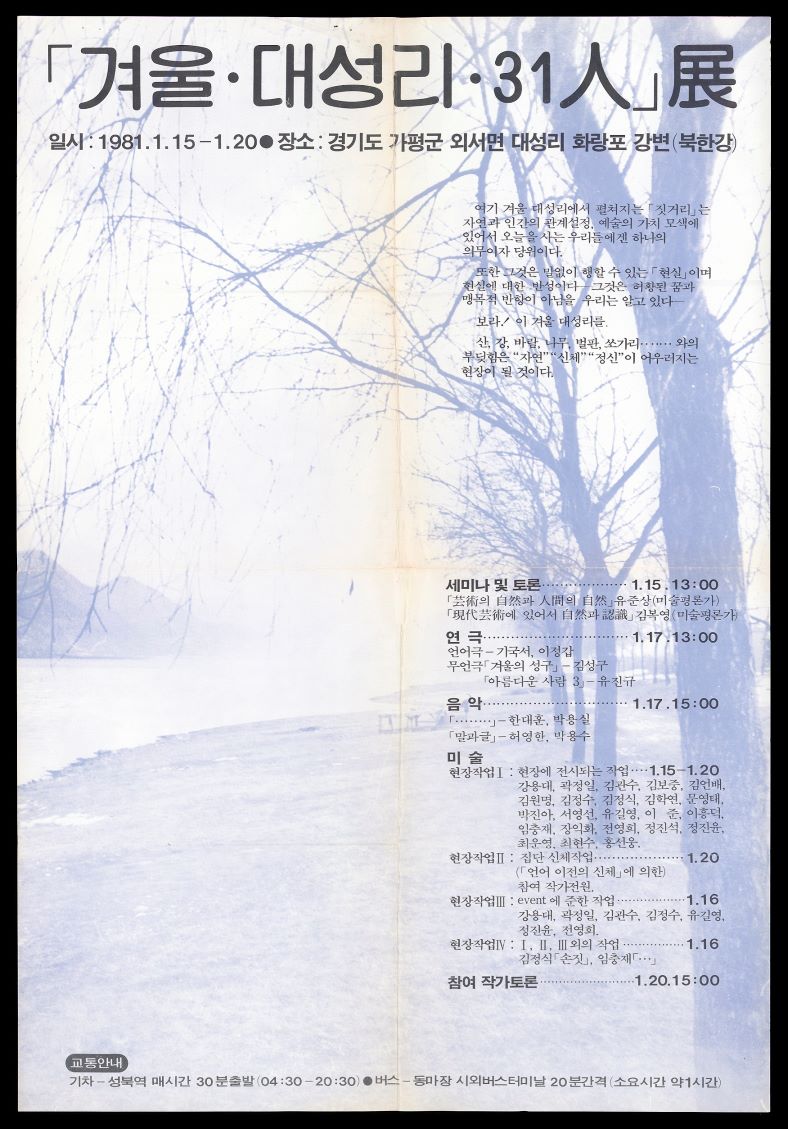
Winter, Open-Air Art Show at Daesung-ri by 31 Artists, Exhibition poster, Image provided by MMCA Art Research Center Collection
Baggat Daeseongri Exhibition
* Source: Multilingual Glossary of Korean Art. Korea Arts Management Service
Related
-
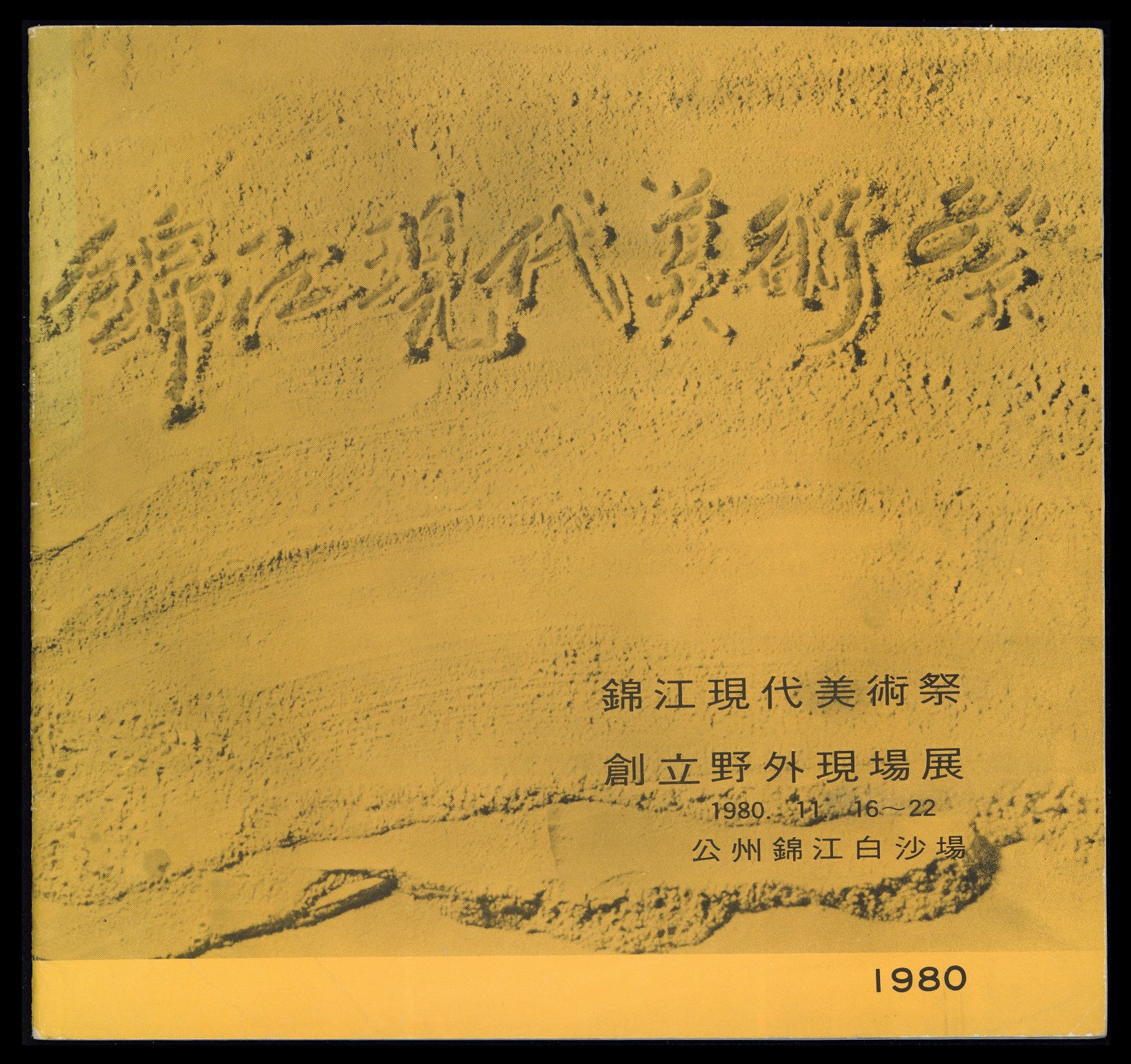
Geumgang Contemporary Art Festival
The Geumgang Contemporary Art Festival was a regional art festival based in the Chungcheongnam-do Province. Its inaugural exhibition was held outdoors on Geumgang Sand Beach in Gongju from November 16 through 22 in 1980, and the festival was held once more indoors at the Daejeon Cultural Center from April 18 to 30 in 1981. Gongju native Rim Dongsik and Daejeon native Hong Myeongseop played leading roles in the festival. Although some Seoul-based artists took part in the festival, most participating artists from 1978 through 1980 were graduates from art universities in Chungcheongnam-do, including Mokwon University, Hannam University, and Kongju National University. Participating artists included Kang Huisun, Kwak Namsin, Ko Seunghyeon, Kim Yong-Ik, Kim Yeongho, Park Ingyu, Shin Dongguk, An Chiin, Oh Jayeong, Yu Geunyeong, Yu Dongjo, Yu Byeongho, Lee Kunyong, Lee Yungu, Lee Euncheol, Lee Jonghyeop, Rim Dongsik, Jeong Gilho, Jeong Deokyeong, Jung Jangjig, Jo Seonga, Ji Seokcheol, Heo Jingwon, and Hong Myeongseop. The Geumgang Contemporary Art Festival was one of several contemporary art festivals held in Daegu, Seoul, Gwangju, and other cities in between the mid-1970s and the early 1980s. The festival aimed to resist the insular nature of local art scenes, discover new artists, and revitalize local art communities. According to its founding statement, the Geumgang Contemporary Art Festival uses the river name “Geumgang” instead of a city name because it is an art event for artists from the Gongju and Daejeon regions and it symbolizes “the spirit of artists who are searching for precious and elevated concepts, such as beauty, elegance, purity, simplicity, lucidness, and brightness and who study them with a scholarly attitude.” The festival also encouraged “young artists in their twenties and thirties who can actively present post-abstract art, installations, and performance art” from among those with connections to the Geumgang regions (born, raised, and working) to participate. A distinctive feature of the Geumgang Contemporary Art Festival is that it started with the premise of featuring outdoor works. At the third Daegu Contemporary Art Festival, participating artists presented performance art on the Nakdonggang River, but they used the outdoors as a mere venue for presenting their works. In contrast, as its subtitle “Outdoor Field Exhibition” suggests, the Geumgang Contemporary Art Festival considered the outdoor field itself as the most important element of art. Rim Dongsik, who played a crucial role in the founding of the festival, along with Ko Seunghyeon, Heo Jingwon, and Kang Huisun, established the YATOO outdoor field art research society in 1981. It studied outdoor art through fresh contact with nature and served as the seedbed of the birth of Nature Art in South Korea.
-
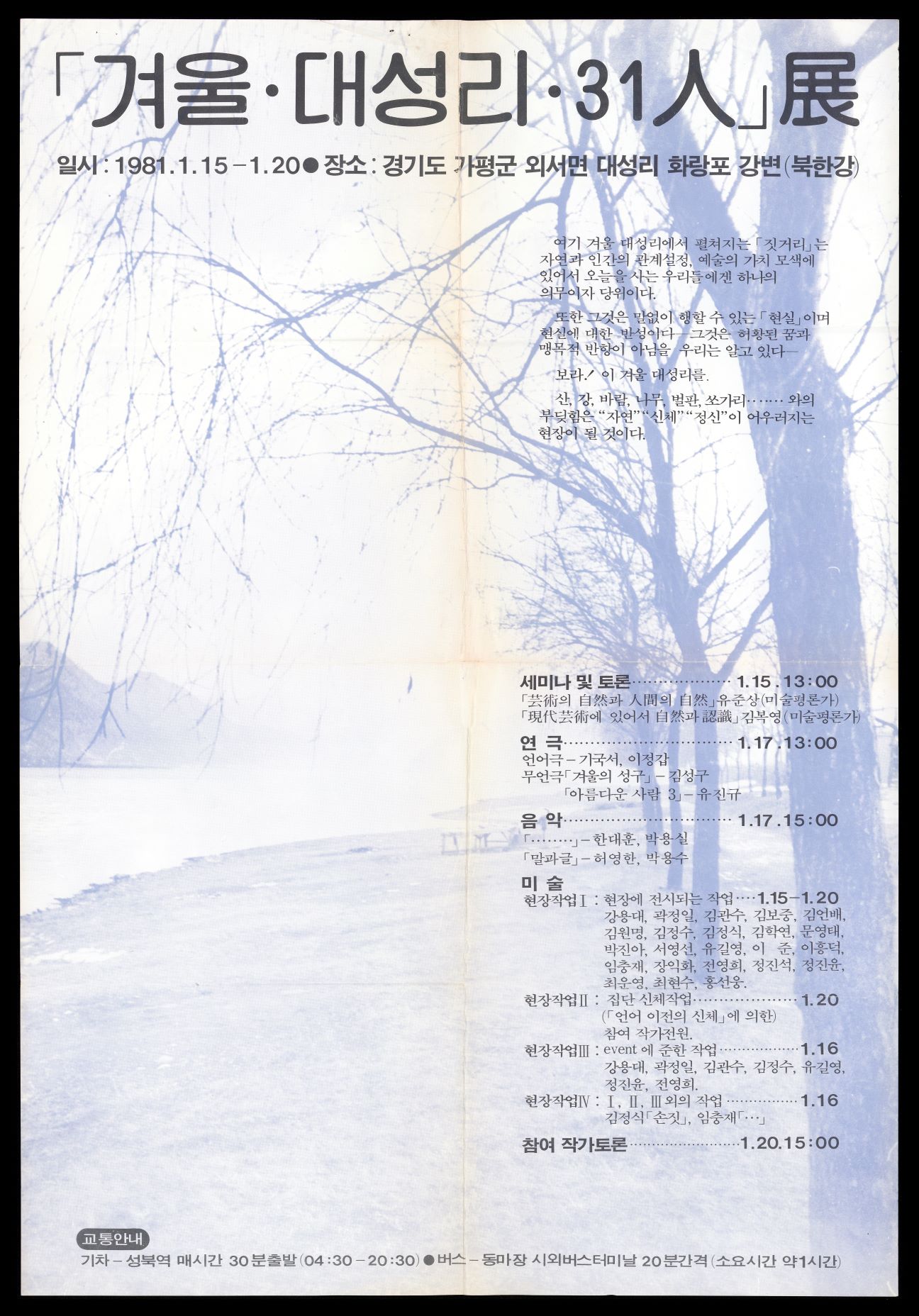
Baggat Art Research Society
An art organization that practiced outdoor site-specific art around the Bukhangang River in 1992 to “deal with all spheres of life of living creatures including humans.” The origin of Baggat Art Association began from the Winter, Open-Air Art Show at Daesung-ri by 31 Artists exhibition held in 1981. 31 participating artists founded the Baggat Art Club in Daesung-ri and a year later changed the name to Baggat Art Research Society. They regarded nature as an inspirational creative medium and presented ritualistic works to challenge the obsessively modern mentality of the time. While dismantling the Winter in Daesung-ri exhibition, the contributors decided to restart as the Baggat Art Association in 1992. In the Association manifesto, they stated that they aimed to “challenge abstract and conceptual Korean art [for accepting] Western influence blindly” and promote Baggat art “as an attempt to coexist with nature.” The Association continue today their art activities relating to nature and ecocriticism.
-
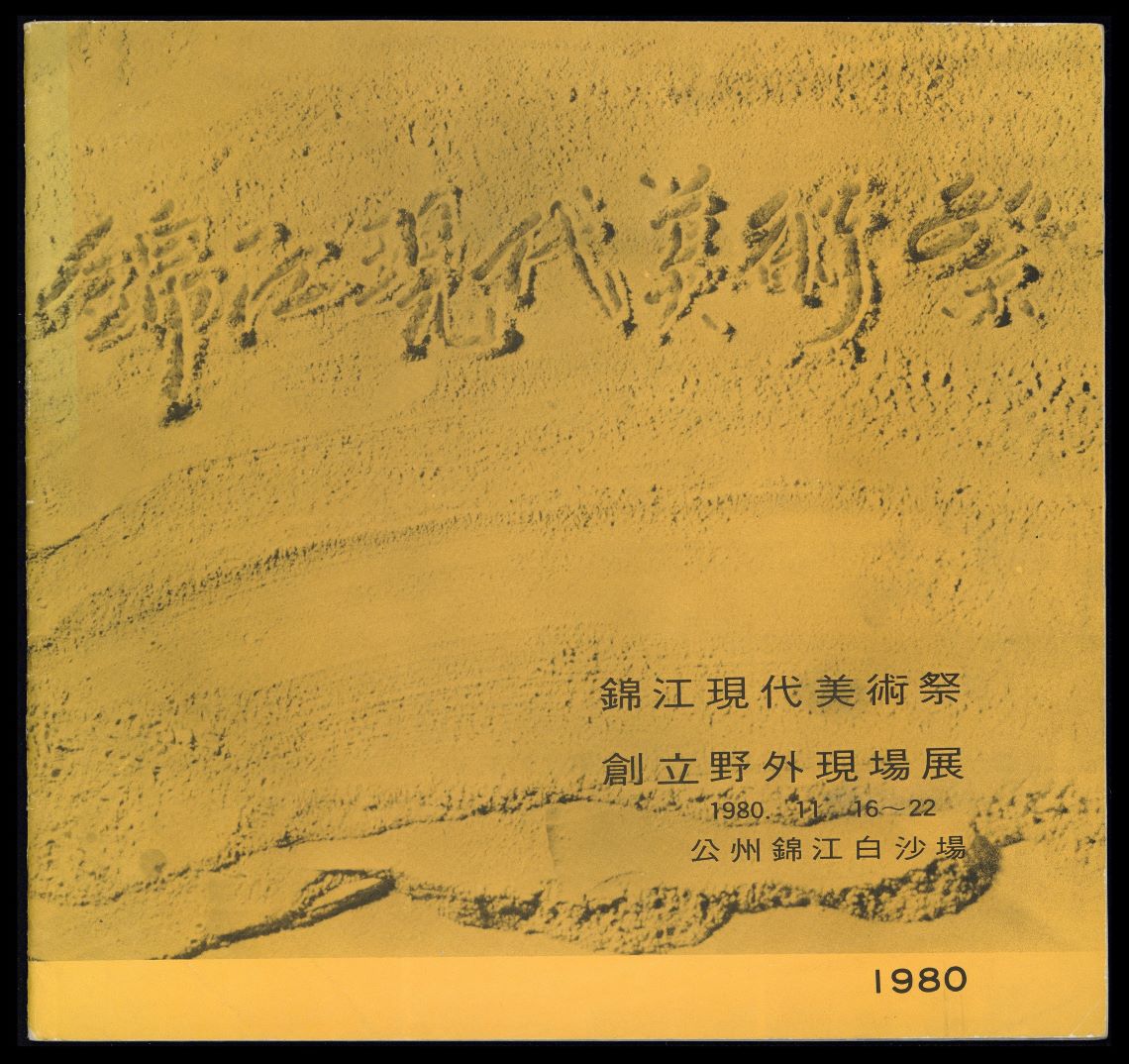
Nature Art
Nature art refers to artistic activities where artists use natural objects or become a part of nature preferably in a desolate natural setting. The members of the YATOO Outdoor Field Art Research Association [Yaoe hyeonjang misul yeonguhoe; YATOO] founded in 1981 refused to present (exhibit) their works indoors and instead presented them in nature, coining the term “nature art” amongst themselves. The origins of nature art can be traced back to the Korean Young Artists’ Association’s thirty outdoor installations in 1976 at Kkotji Beach in Anmyeondo Island and in Gwangreung Forest in Gyeonggi-do Province. Rather than creating works indoors and installing them outdoors, they presented works that used nature as subject matter and were installed in nature. Among the participating artists were Chung Kwanmo, Kim Kwangwoo, Noh Jaeseung, and Rim Dongsik. In the beach and forest, they tried to incorporate the sky, sun, moon, stars, darkness, light, air, water, horizon, sand, tree, forest, fallen leaves, soil, and earth in their original state into their works. Their activities were short-lived and led to the Geumgang Contemporary Art Festival held by Rim Dongsik and Hong Myeongseop in 1980 by the Geumgang River. However, the festival also ended with the first edition. Since 1981, the YATOO artists, including Rim Dongsik, Ko Seunghyun, Lee Eungu, Heo Gang, and Hur Jinkwon, became active around the Geumgang River, inheriting the practice of outdoor installation and establishing it as a mode of artistic expression. They staged various works of performance art in nature with their bare bodies or created installations using natural objects available in nature. Initially, they installed man-made objects such as plastic and balloons in nature, and then gradually used stones, sand, grasses, tree branches, fallen leaves, shells, conches, and even animal feces that they found in nature. Over time, their oeuvres have come to include the process of decomposition in nature.
Find More
-
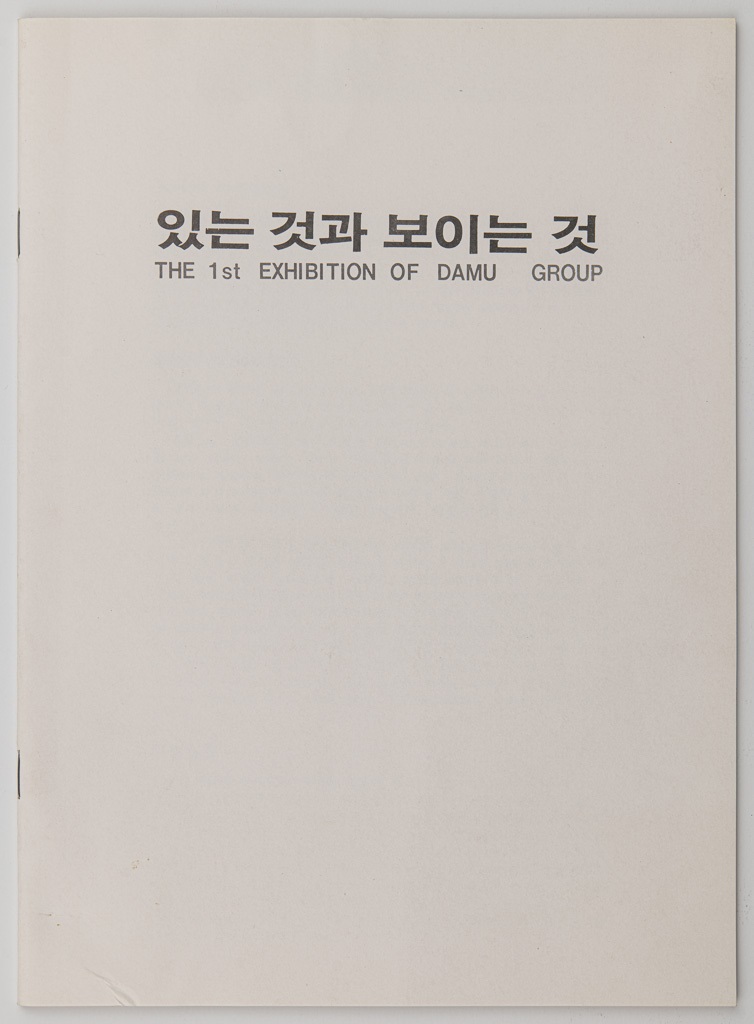
DAMU Group
DAMU Group, an art group active from 1980 to 1983, was founded based on the recognition of the 1970s as a period of juxtaposition between the real and the illusionary. It curated exhibitions on the theme of what is and what is visible in an effort to find a turning point for a new mode of existence different from such juxtaposition. Accordingly, the group experimented with new art forms that were different from existing ones and presented works and exhibitions aimed at practicing contemporary ideas and spirit. Its inaugural exhibition The First Exhibition of Damu Group was held on November 6, 1980 at the Art Center of the Korean Culture and Arts Foundation Art Center. Seven artists participated in the exhibition including Kim Jeongsik, Kim Hakyeon, Lee Heungduk, Yim Chungjae, Jeong Jinseok, Choe Hyeonsu, and Hong Seonwung, all of whom were graduates from Chung-Ang University. At the time, they rejected the monochromatic painting style and criticized the uniform formalism and art system of the 1970s as a barrier to overcome. DAMU Group viewed things as existing in a “complementary relationship” with other things and argued that the true nature of things is revealed in their organic relationship. In this light, the title of its founding manifesto was announced as “The Complementary Relationship of Things.” Since a single thing or a concrete form cannot define its true nature, the group thought that how things interact with each other should be explored to understand them. Thus, the artists of the group produced works by utilizing photographs of human figures and geometric forms, installing two or more objets, or adding scratches on the copies of real objects. After its inaugural exhibition, the group organized another exhibition Winter, Open-Air Art Show at Daesung-ri by 31 Artists in January 1981 at Hwarangpo on the banks of the Bukhangang River in Daeseong-ri, Gapyeong-gun, Gyeonggi-do Province. In July 1981, it held its second group exhibition at the Art Center, and in March 1982 it presented The Exhibition of Conversive Art. In August of the same year, the group held the exhibition The Straight Forwardness of Consciousness, the Echo, in which small groups Jeongae, Hoengdan, and TA-RA as well as the DAMU Group participated. After the third group exhibition What Is and What Is Visible held in August 1983 at the Art Center, the DAMU Group’s activities ceased because its members joined several Minjung art groups or went abroad to study and their ideas about art’s social engagement slightly differed.
-
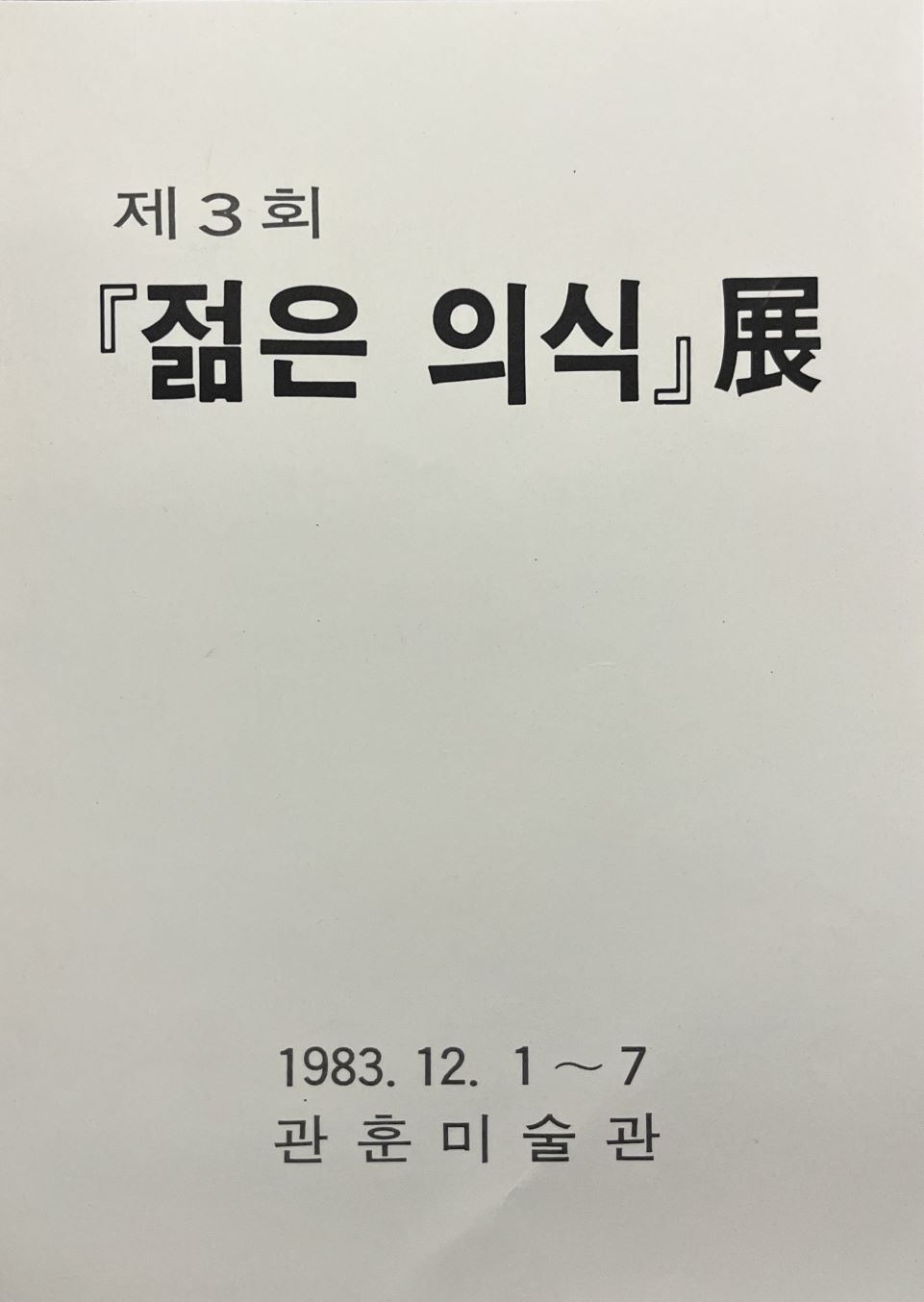
Young Minds
Young Minds was a special exhibition organized from 1982 through 1987 by artists in small groups who were active in the 1980s with the goal of showcasing the new aesthetics of the younger generation. The Young Minds [Jeolmeun uisik], which was also the title of its exhibition, had the character of a small group, but it was more of a curated exhibition. Young Minds originated from young artists’ reflections and awareness of the reality of the military regime in the early 1980s, the rapid transition to a capitalist society, and the art scene dominated by Western art. They intended to reveal young consciousness by finding “living art.” The exhibition was mainly curated by Jang Gyeong-ho, who had served as a curator at Hangang Museum since its opening in 1984. Accordingly, the Young Minds exhibition began to be held at Hangang Museum from its fourth edition. Young Minds preceded the exhibition Sidaejeongsin (Zeitgeist) (Third Museum of Art, 1983) that the Sidaejeongsin (Zeitgeist) Planning Committee organized to present activities of small groups together. The participating artists of Young Minds were diverse, including those who had joined Reality and Utterance [Hyunsilgwa bareon], Imsulnyeon, Hoengdan, and Winter · Daeseong-ri. The first edition was held from March 11 through 17, 1982 at the Deoksu Museum of Art. Its thirty-six founding members included Kang Yobae, Kang Yongdae, Kang Jinmo, Ko Kyeong-hun, Kwak Taeho, Kwon Chilin, Kim Bo-jung, Kim Sung-tae, Kim Wonmyeong, Kim Jinyeol, Kim Hak-yeon, Moon Youngtae, Park Jae-dong, Park Hongsun, Son Kihwan, Lee Myeonghun, Lee Sangho, Lee Yeongbae, Lee Heungduk, Yi Heechoung, Yim Chungjae, Jang Gyeongho, Jang Changik, Jung Bocsu, Cheong Jinyun, Choe Cheolin, Hwang Sehun, Hong Seonwung, and Hong Suncheol. The second edition was held in February 1983 at Kwanhoon Gallery. The participating artists were Kang Yongdae, Ko Kyeong-hun, Kwon Chilin, Kim Bo-jung, Kim Yunjin, Moon Youngtae, Park Geon, Lee Seop, Lee Heungduk, Yim Chungjae, Jang Gyeongho, Jung Bocsu, Jeong Jinseok, Ham Yeon-sik, Hong Seonwung, Hong Suncheol, and Hwang Julie. The third edition was also held at Kwanhoon Gallery with the participants Ko Kyeong-hun, Kim Bo-jung, Kim Jinyoung, Mun Yeongtae, Park Hyeongsik, Song Chang, Ahn Sungkeum, Lee Seop, Lee Chulsoo, Lee Heungduk, Jang Gyeongho, Jung Bocsu, Hong Seonwung, Hong Sungdam, and Hong Suncheol. From the fourth edition, the exhibition was held at Hangang Museum. Among the participating artists in the fourth edition held in September 1984 were Ko Kyeong-hun, Kwon Chilin, Kim Bo-jung, Kang Yongmun, Kim Jinyeol, Park Buldong, Lee Sangho, Lee Seop, Lee Heungduk, Jang Gyeongho, Jung Bocsu, and Hong Suncheol. The fifth edition was held in March 1985. The participants were Ko Younghoon, Kwon Chilin, Kim Bo-jung, Kim Jinyeol, Kim Hwanyeong, Park Jeongae, Park Sangmo, Yu Seongsuk, Lee Sangho, Lee Seop, Lee Eunsun, Lee Heungduk, Jang Gyeongho, Jang Myeonggyu, Jung Bocsu, Cheong Jinyun, Jo Seonghwi, Han Jaehun, Heo Eunyeong, Hong Seongi, and Hong Suncheol. The sixth edition held in April 1986 featured works by thirty-eight artists, such as Kim Gyeongja, Kim Jeongae, Yang Hyangnam, Lee Kyonghee, Jo Seonghwi, Choi Minhwa, and Hong Hwanggi. The seventh and final edition was held in March 1987, and its participating artists included Kwon Yeongro, Lee Gangyong, Lee Sangho, Roh Jaesoon, Lee Chungwoon, Bae Unyeong, Lee Heungduk, Jang Gyeongho, and Hong Suncheol. Jang Seokwon defined Young Minds as the “aesthetics from below” of the younger generation and classified their tendency as experiential self-expression, historical reality, and new forms. You Hongjune characterized Young Minds as “a new movement in the 1980s that rebelled against aestheticism and formalism, which had dominated Korean art, and began to recognize and reflect on the nature of art.”






